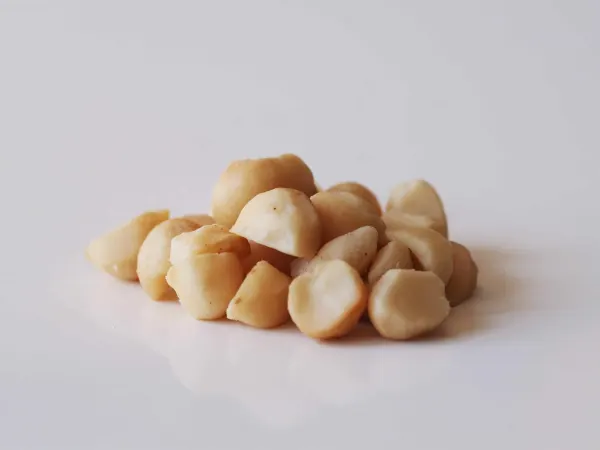Macadamia Nut
Tree Nut
Age Suggestion
6 months
Iron-Rich
Yes
Common Allergen
No

When can babies have macadamia nuts?
Macadamia nuts, if they are finely ground or served as macadamia nut butter mixed into other foods, may be introduced as soon as baby is ready to start solids, which is generally around 6 months of age. Whole and chopped macadamia nuts, as well as macadamia nut butter, are choking hazards for babies and children, so read our preparation by age section closely before serving.
Macadamia nuts grow on beautiful evergreen trees in rainforests around the world. The plant originated in Australia, where they have been known as bauple, boombera, gyndl, and jindilli by First Nations peoples for centuries. Long before European colonization of the region, the nut was prized for its multiple gifts—its nutrients aided lactating moms, its rich oils were turned into ceremonial paint, and the hard-to-crack shell made the nut a delicacy that could be traded between communities.
Are macadamia nuts healthy for babies?
Yes. Macadamia nuts are a rich source of thiamine, a B vitamin important for energy and nerve function. They also contain protein, healthy fats, and fiber, making macadamia nuts an excellent food for optimal growth and digestion. Lastly, macadamia nuts—like other nuts—are a great source of iron, making the nut particularly healthful for babies on plant-based diets.
★Tip: Like most tree nuts, macadamia nuts can go rancid. Macadamia nuts can keep fresh in the refrigerator for up to 1 year, and in the freezer for up to 2 years.
Are macadamia nuts a common allergen?
No, macadamia nuts are not a common allergen globally. However, macadamia nut allergy is more prevalent in Australia, where the nut is a native crop. Macadamia nuts are in the tree nut family. While only 0.5 to 1.2% of the population is allergic to tree nuts, it is usually life-long: only 9% of children with a tree nut allergy will outgrow it. Although macadamia nut allergy is not especially common, when it does occur, reactions can be severe.
Due to similarities in the protein structure of these nuts, individuals who are allergic to pecans, walnuts, or hazelnuts may be somewhat more likely to be allergic to macadamia nuts. There also appears to be a strong relationship between co-sensitization (but not necessarily co-allergy) to macadamia and coconut. Reactions to macadamia can range from mild oral allergy symptoms to severe system-wide reactions (anaphylaxis).
Although an allergy to one tree nut increases risk of allergy to another, keep in mind that being allergic to one nut does not necessarily mean that all nuts need to be removed from the diet. Having as diverse of a diet as possible, even within the confines of food allergies, is important for a child’s nutrition and quality of life. If the child has a macadamia nut allergy, work with an allergist to determine if other tree nuts can be safely incorporated into the diet.
For most babies, there is no need to complete allergy testing before introducing tree nuts into the diet, even if there is a family history of food allergy. However, if baby has severe eczema or has already experienced an allergic reaction, or you suspect baby may be allergic to nuts, make an appointment with your primary care clinician or a pediatric allergist before introducing macadamia nuts at home. Your doctor can help you determine if macadamia nuts can be safely introduced in the home setting, or if supervised introduction in the clinic would be preferable.
When it’s time to introduce the nut, offer a small quantity (such as a pinch of finely ground nut or 1/8 teaspoon of smooth macadamia nut butter thinned with breast milk, formula, or water) at first. If there is no adverse reaction, you can increase the quantity over future meals.
Are macadamia nuts a choking hazard for babies?
Yes. Whole nuts, nut pieces, and globs of nut butters are choking hazards for babies and young children. To reduce the risk, prepare and serve macadamia nuts and macadamia nut butter in an age-appropriate way. As always, make sure you create a safe eating environment and stay within an arm’s reach of baby during meals. For more information on choking, visit our section on gagging and choking and familiarize yourself with the list of common choking hazards.
Videos
Can babies drink macadamia nut milk?
No. Prior to 12 months, the only liquids an infant should consume are breast milk, formula, and, if the baby is older than 6 months of age, water in small amounts (less than 2-4 ounces a day) in an open cup. If macadamia nut milk is used as an ingredient in solid food (such as oatmeal), then it is acceptable to serve before 12 months of age.
If, after the first birthday, you’d like to introduce macadamia nut milk as a beverage, it’s fine to do so, but know that macadamia nut milk lacks adequate calories, fat, and protein for a plant-based milk for toddlers (typically fortified soy or pea milk are more nutritious). See our Milk FAQs to learn more.
How do you serve macadamia nuts to babies?
Every baby develops on their own timeline, and the suggestions on how to cut or prepare particular foods are generalizations for a broad audience.
6 months old +:
Grind macadamia nuts in a food processor until completely fine and no large pieces remain. If you do not have a food processor, you can pound the nuts in a cloth with a hammer, with a mortar and pestle, or with the end of a wine bottle. To serve the ground nut, sprinkle a small amount on other foods, such as fish, quinoa, warm cereal, or yogurt. You can also roll slippery foods like sliced fruit in the ground nut, which adds texture that makes it easier for baby to pick up. If you’d like to make a baby-friendly nut butter, keep the food processor going until the nuts form a paste, then add yogurt, water or another baby-friendly liquid to thin the nut butter into a non-sticky, smooth spread with no clumps. This can be spread very thinly on other age-appropriate foods.
12 months old +:
Continue to finely grind macadamia nuts and sprinkle on fruits and vegetables or to incorporate macadamia nut butter into other foods such as yogurt and warm cereals, or thinly spread on toast. At this age, you may also introduce macadamia nut milk as an occasional drink.
36 months old +:
Continue to serve finely ground macadamia nuts and use macadamia nut butter as you wish. If the child has developed mature eating skills (taking small bites with their teeth, moving food to the side of the mouth when chewing, chewing thoroughly before swallowing, not stuffing food in their mouths, and finally, the ability to identify and spit out foods when it is not well chewed, AND is able to eat softer nuts like walnut and pecans with ease, they may be ready to learn how to eat whole macadamia nuts. Just remember that nuts and nut pieces are considered choking hazards until age 4 and even beyond by all governing medical bodies.
Macadamia nuts are particularly risky and challenging to eat as they are firm, difficult to take a bite out of, and are small and round. We'd recommend starting with other whole nuts before offering macadamia nuts.
To model how to eat macadamia nuts safely, start by telling the child: "This is a hard one. Watch me." Then, show the toddler how to place the macadamia nut in-between your front teeth. Hold the nut between your teeth and exaggerate moving the nut to your molars with your tongue. Chew with your mouth open (you can even demonstrate by opening and closing your hands at the same time). Once you have chewed the nut well, open your mouth to show your toddler how it has been broken down. Say, "I moved it to my big strong teeth to chew it. It needs a lot of chewing." Demonstrate a couple of times before offering the toddler a macadamia nut to do the same.
To coach a child through eating a whole macadamia nut safely, say, "Your turn to try." NEVER PUT A NUT IN YOUR TODDLER'S MOUTH. If the child takes a bite and chews thoroughly (they may spit the nut out for many months as they get used to the texture), offer one or two more nuts at a time (but never more) to keep the pace slow. If the child does not use their teeth to bite or attempt to move the nut to the molars to break it down, we recommend coaching the child to spit the nut out and waiting a few weeks more to practice chewing other nuts that are less challenging.
It is important to help the child stay engaged with the task, and part of that is modeling that safe chewing takes place when we are not talking, singing, etc. A highly animated child who is talking, yelling, or singing while practicing eating nuts increases choking risk. After practicing nuts with a toddler, make sure their mouth is clear before taking them out of the high chair. Never allow a toddler to walk around with nuts or nut pieces in their mouth.
Our Introducing Allergens page offers all the guidance you need for dealing with common allergens.
Written by
Expert Tips Delivered to Your Inbox
Sign up for weekly tips, recipes and more!
The content offered on SolidStarts.com is for informational purposes only. Solidstarts is not engaged in rendering professional advice, whether medical or otherwise, to individual users or their children or families. No content on this site, regardless of date, should ever be used as a substitute for direct medical advice from your doctor or your medical or health professional, nutritionist, or expert in pediatric feeding and eating. By accessing the content on SolidStarts.com, you acknowledge and agree that you are accepting the responsibility for your child’s health and well-being. In return for providing you with an array of content “baby-led weaning” information, you waive any claims that you or your child may have as a result of utilizing the content on SolidStarts.com.













